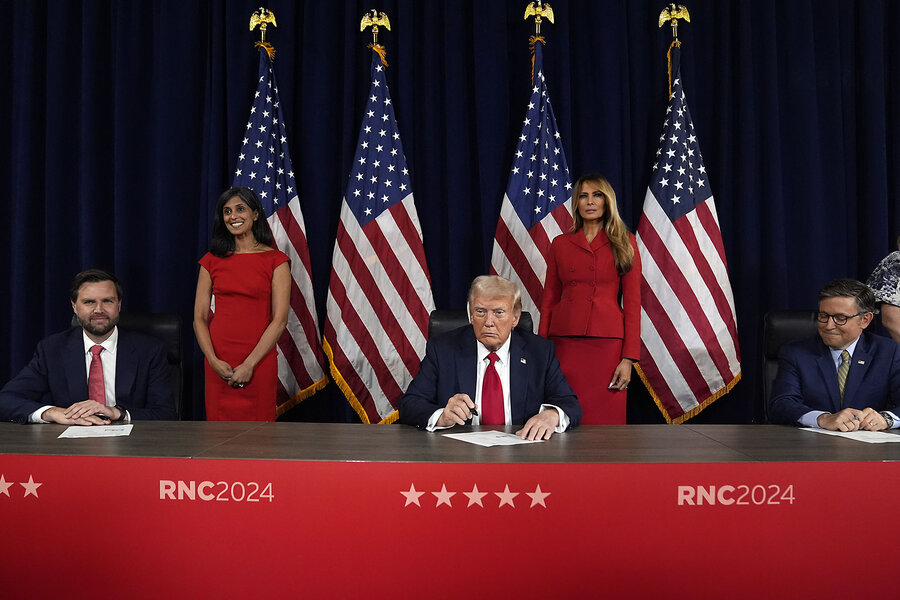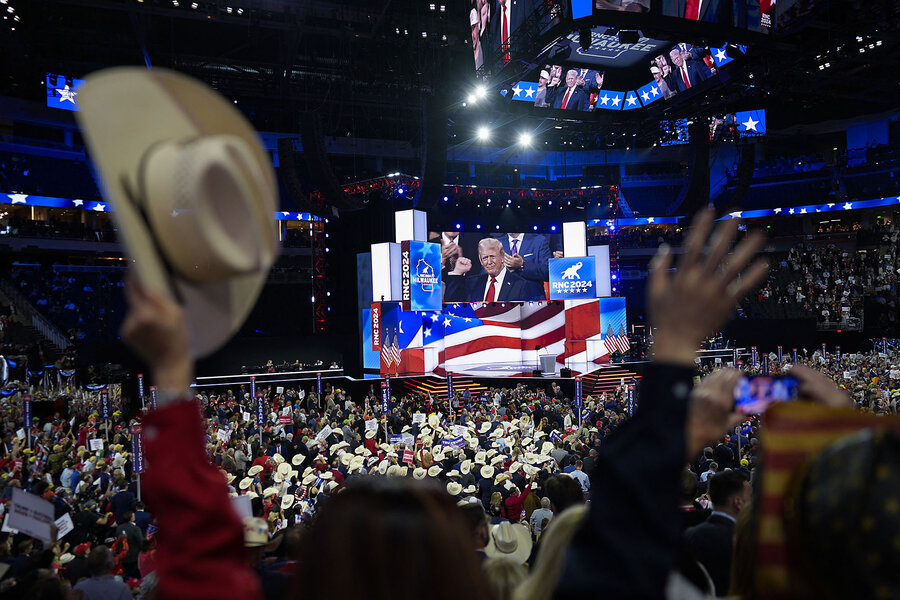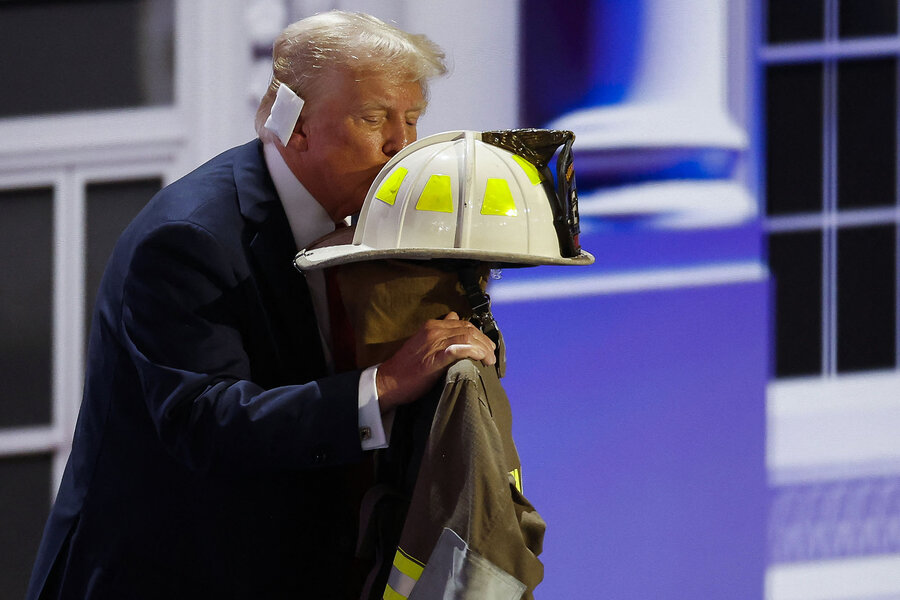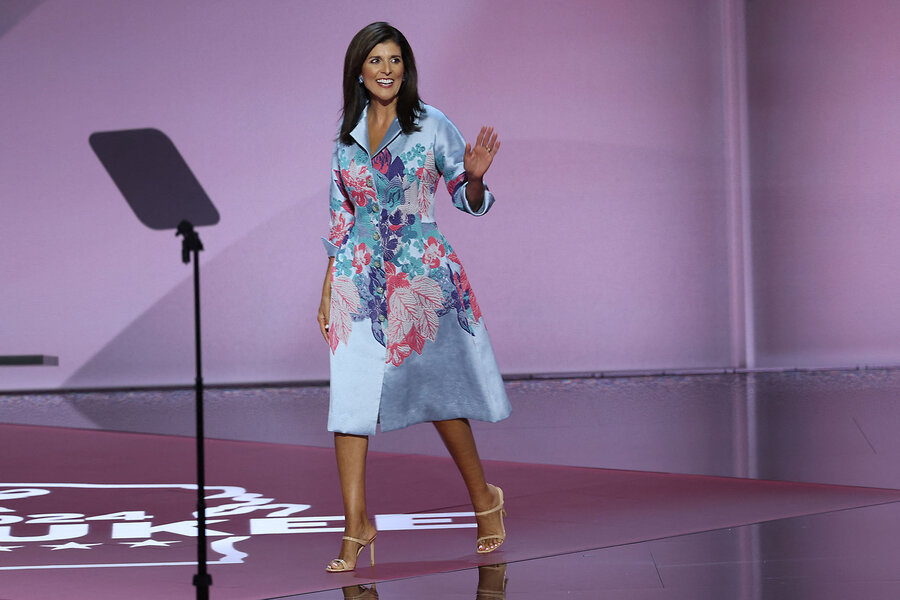Over four days at their national convention this week, Republicans promised a new Donald Trump – a man who had been permanently transformed by a failed assassination attempt just days earlier.
When Mr. Trump took the podium Thursday evening, it did seem – for the first 15 minutes – that he tried to project a unifying message.
Why We Wrote This
In accepting the Republican presidential nomination, Donald Trump envisioned a nation “more united than ever before.” But his speech included sharp attacks on President Joe Biden, as both parties also confront open or latent fissures within.
“The discord and division in our society must be healed,” he said. “I am running to be president for all of America, not half of America.”
Soon after, however, he shifted back into old patterns. The crowd roared when he vowed to enact the “largest deportation operation,” and when he referred to President Joe Biden as worse than America’s 10 worst presidents put together.
Mr. Trump’s speech capped a week that has felt less like a warmup for the campaign’s final stretch and more like an election night victory party.
The GOP’s palpable air of optimism and camaraderie was fueled by two events outside Wisconsin that were out of Mr. Trump’s control. One was the unifying effect of the assassination attempt in Pennsylvania. The other is the chaotic unraveling taking place among Democrats back in Washington, with the drip-drip-drip of congressional statements calling for Mr. Biden to end his candidacy.
Over four days at their national convention this week, Republicans promised a new Donald Trump – a man who had been permanently transformed by a failed assassination attempt just days earlier and was ready, finally, to stop attacking and start uniting.
Delegates remarked on the former president’s visible emotion each night as he entered the arena with a bandaged ear, growing emotional themselves as they described the face of a changed man. Advisers told reporters that Mr. Trump was reassessing his messaging, and Mr. Trump himself said as much in a post-shooting interview with the Washington Examiner. His speech Thursday night would bring the whole country together, he said, if not the whole world.
When Mr. Trump took the podium Thursday evening, it did seem – for the first 15 minutes – that he tried to do just that.
Why We Wrote This
In accepting the Republican presidential nomination, Donald Trump envisioned a nation “more united than ever before.” But his speech included sharp attacks on President Joe Biden, as both parties also confront open or latent fissures within.
“The discord and division in our society must be healed,” said Mr. Trump, before he formally accepted the Republican nomination. “I am running to be president for all of America, not half of America. Because there is no victory in winning for half of America.”
Soon after, however, he shifted back into old patterns, abandoning his teleprompter for long stretches. In a rambling 92-minute performance, Mr. Trump repeated many of his usual talking points from rallies. The crowd roared when he vowed to enact the “largest deportation operation,” and when he referred to President Joe Biden as worse than America’s 10 worst presidents put together – despite a pre-speech promise to not refer to Mr. Biden by name.
Republican unity – with fuel from beyond Milwaukee
In many ways, Mr. Trump’s speech was the culmination of a week that has felt less like a warmup for the campaign’s toughest, final stretch and more like an election night victory party. And the GOP’s palpable air of optimism and camaraderie was fueled by two events outside Wisconsin that were entirely out of Mr. Trump’s control.

Republican presidential candidate Donald Trump and vice presidential candidate J.D. Vance sign paperwork to officially accept their nominations July 18, 2024, in Milwaukee, as House Speaker Mike Johnson (right), former first lady Melania Trump, and Mr. Vance’s wife, Usha Chilukuri Vance, look on.
After the assassination attempt against Mr. Trump in Pennsylvania just days ago, his supporters, many donning makeshift ear bandages mimicking the former president’s, said they felt inspired anew. “It’s like when something bad happens in your family and you all band together,” said Gary Leffler, an alternate delegate from Iowa. “The assassination attempt has drawn everyone that much closer. It had an extremely unifying consequence to it.”
At the same time, the chaotic unraveling taking place among Democrats back in Washington, with the drip-drip-drip of congressional statements against Mr. Biden’s candidacy and increasingly dire poll numbers – showing Mr. Trump with a clear lead – made attendees here almost giddy with anticipation.
When asked about the Republican Party’s sudden unity, Peter Navarro, a former Trump adviser who spoke at the Republican National Convention on Wednesday evening after being released from prison for defying a congressional subpoena related to the Jan. 6 Capitol riot, answered in the reverse. “The Democratic Party,” he said, “is in complete disarray.”

An attendee cheers as former President Donald Trump arrives on Day 4 of the Republican National Convention in Milwaukee, July 18, 2024.
Political disarray, of course, is what happens when a party believes it is on track to lose. It was after Mr. Biden’s disastrous June 27 debate performance that Democrats’ internal strife began in earnest. And as Republicans are now demonstrating, it’s easy to paper over differences and come together when your team is running up the scoreboard.
The display of GOP unity this week was all the more remarkable, coming after a year of vicious infighting in the House of Representatives that led to the ouster of a Republican speaker. And certainly, it stood in stark contrast to the bitter internal divisions on view in 2016 over Mr. Trump’s candidacy – divisions that over the past eight years caused many anti-Trump Republicans to leave the party.
It’s clearly Mr. Trump’s party more than ever. But as he leaves Milwaukee as the Republican presidential nominee for a third time, only time will tell if this newfound party unity is conditional – if Mr. Trump and his supporters will insist on total fealty going forward, or if the party’s full-throated support of Mr. Trump is in part a product of polling leads.
“I think Trump has done an excellent job unifying people. … But also, I give a lot of credit to the Democrats. Their division unites us more,” former Speaker of the House Kevin McCarthy said in an interview Thursday afternoon. “I hope Republicans learn from this, that we’re stronger together and we’re weaker divided. A house divided cannot stand.”

Republican presidential nominee Donald Trump kisses the turnout coat and helmet of former Buffalo Township Volunteer Fire Department Chief Corey Comperatore, who was killed at the Trump rally in Pennsylvania last week, as Mr. Trump gives his acceptance speech in Milwaukee, July 18, 2024.
Internal GOP divides linger
Mr. McCarthy’s own political demise, of course, points to the recent internal cracks that have, for now, been papered over. The former speaker was ousted last year by a small faction of disgruntled party members – one of whom, Florida Rep. Matt Gaetz, was caught taunting Mr. McCarthy here as he was giving an on-camera interview.
It’s also notable who wasn’t in the arena to hear Mr. Trump’s promises of togetherness.
His former vice president, Mike Pence, was fishing in Montana. The 2012 Republican presidential ticket – Sen. Mitt Romney of Utah and former Rep. Paul Ryan – wasn’t here. Republican former President George W. Bush did not make an appearance, nor did former Vice President Dick Cheney or his daughter, former Wyoming Rep. Liz Cheney. More than half a dozen Republican Senate candidates gave prime-time speeches Tuesday evening, but former Maryland Gov. Larry Hogan, who has so far declined to endorse Mr. Trump while running for a Senate seat that would be a dream pickup for Republicans, was absent.
“You can always say, ‘Oh, so-and-so didn’t come.’ Who cares? It’s their right not to come,” said New York Rep. Mike Lawler.
Instead, many attendees noted all the onetime Trump opponents who were present, like primary rivals Florida Gov. Ron DeSantis and former South Carolina Gov. Nikki Haley, who endorsed Mr. Trump for the first time in her convention speech.

Former Republican presidential contender Nikki Haley takes the stage on Day 2 of the Republican National Convention at the Fiserv Forum in Milwaukee, July 16, 2024.
“You saw many of President Trump’s primary opponents here speaking; they were well received,” said Ohio Republican Gov. Mike DeWine. He said that this convention, the 10th he has attended, was more unified than the Cleveland convention he presided over as home-state governor eight years ago.
Still, when Ms. Haley first came onstage Tuesday, a smattering of boos rippled from the crowd. The greeting for Senate Minority Leader Mitch McConnell, the longest-serving Senate party leader in U.S. history, when he announced Kentucky’s delegates for Mr. Trump on Monday, was almost hostile.
Trump-driven shifts are visible in Republican platform
“The party has moved from an elitist party to a working-class party. That includes the Bushes and Mike Pence,” said Mary Downey, an alternate delegate from Florida wearing an American flag dress. “It’s not the Republican Party of 30 years ago anymore.”
That’s true not just in terms of personnel, but also in policy. In Republicans’ 2024 party platform, two longtime pillars – abortion and guns – were largely missing from this year’s document, which Mr. Trump and his team reportedly rewrote themselves and drastically shortened from the 2016-2020 version.
“As somebody that’s a Republican that believes in pro-life and believes in character that matters and believes in global leadership, I want to stay in the party and fight for some of the principles that I believe in,” said former Arkansas Gov. Asa Hutchinson, one of the few Trump-critical Republicans who attended the convention without endorsing the former president, in an interview Monday. But he seemed resigned to the fact that this wasn’t the old GOP he came up in.
“It’s his party,” said Mr. Hutchinson.
Not helping Mr. Hutchinson’s decision is Mr. Trump’s choice for vice president. Ohio Sen. J.D. Vance was “the most MAGA person that was out there” among the known contenders, said Mr. Hutchinson, who worried about Mr. Vance’s opposition to supporting Ukraine. Governor DeWine of Ohio voiced similar concerns.
“It was good for J.D. Vance last night to openly acknowledge that we have differences,” said Mr. DeWine of the vice presidential nominee’s speech Wednesday evening.
But as Mr. Trump’s thousands of delegates cheered to his greatest hits during his convention speech, intraparty policy differences didn’t seem top of mind. And the former president himself seemed to recognize the gift of this political moment.
“I better finish strong or else I’ll blow it,” said Mr. Trump. “And we can’t do that.”
>>> Read full article>>>
Copyright for syndicated content belongs to the linked Source : The Christian Science Monitor – https://www.csmonitor.com/USA/Politics/2024/0719/trump-republican-convention-party-unity?icid=rss































